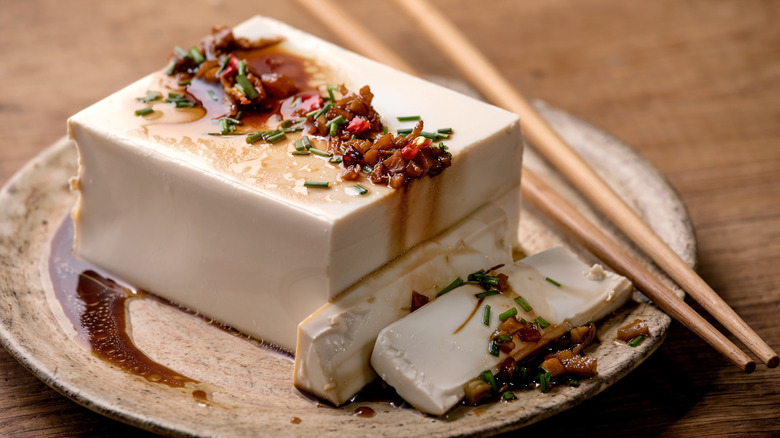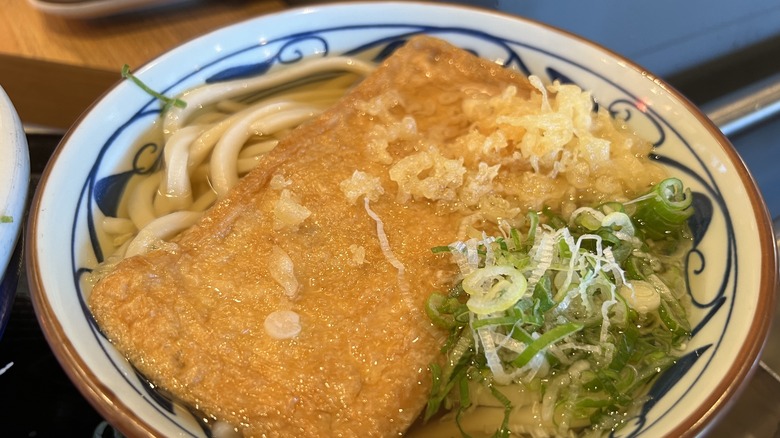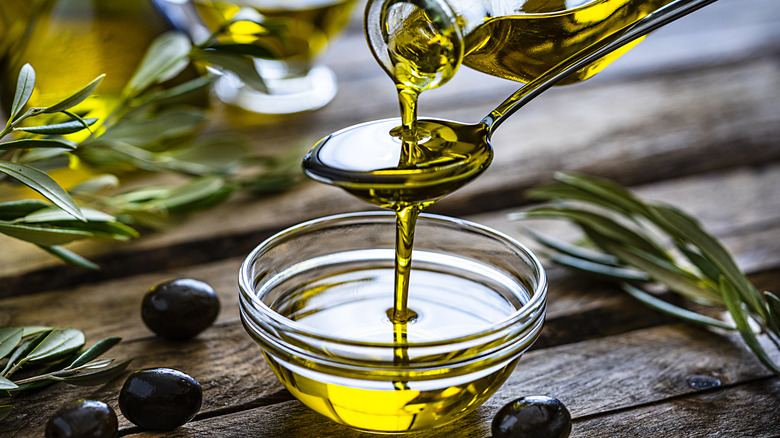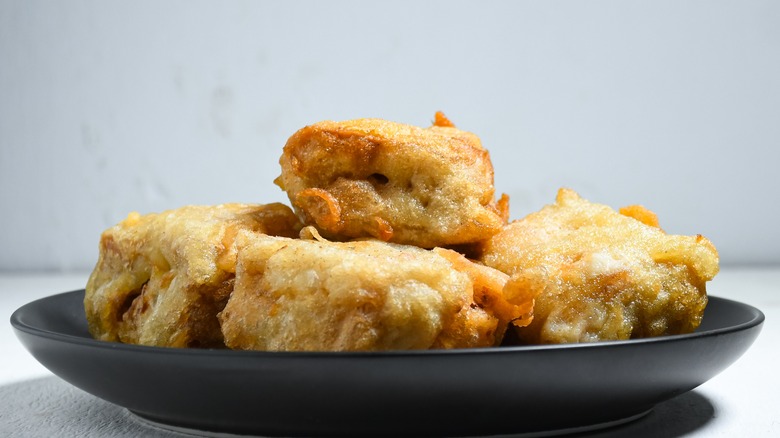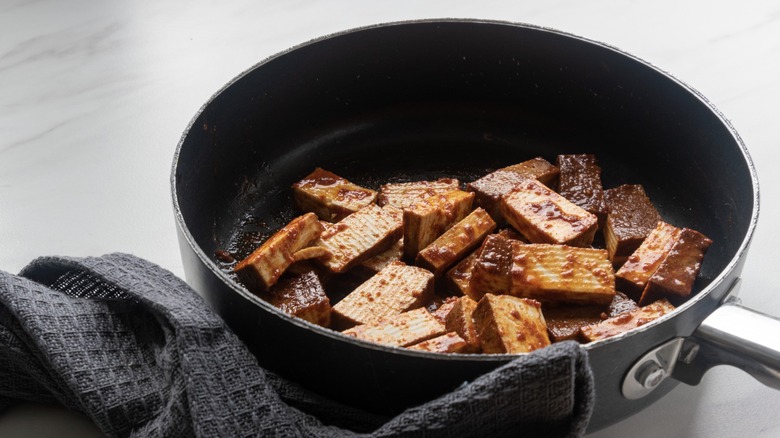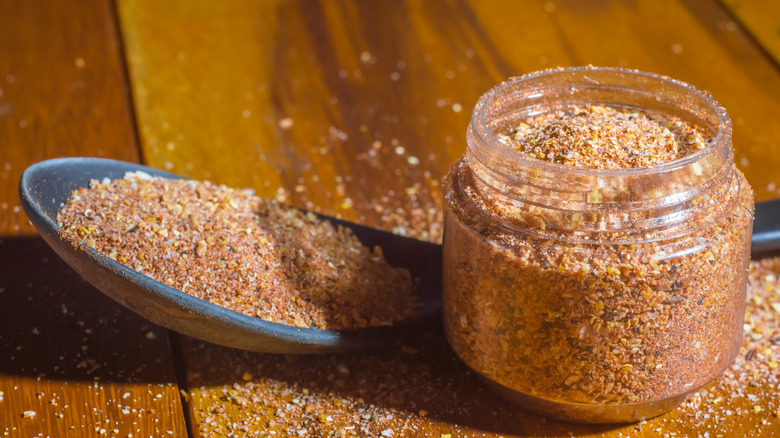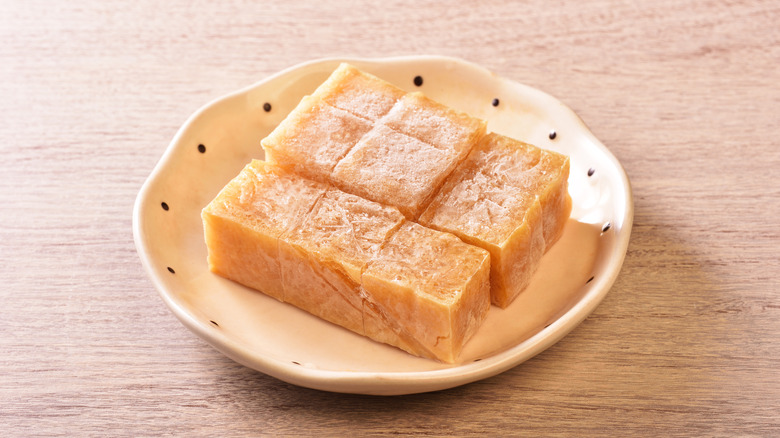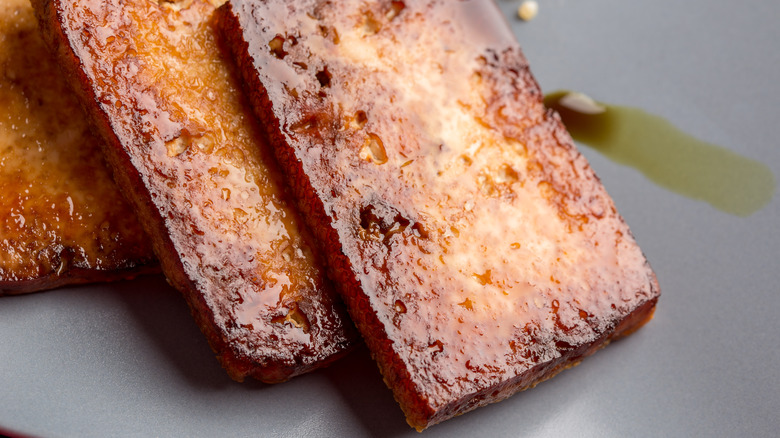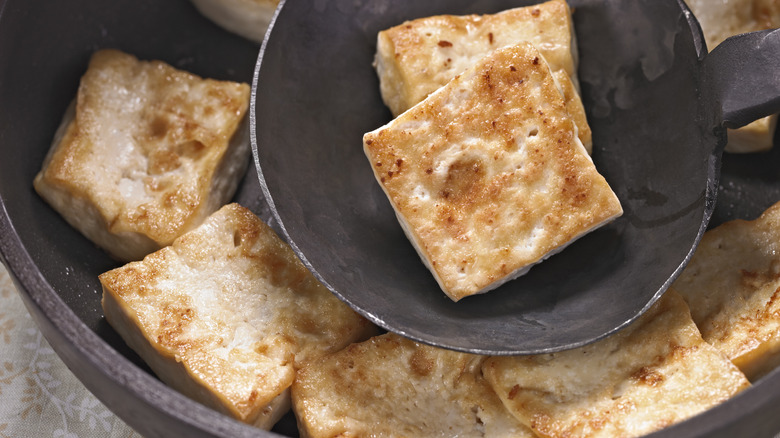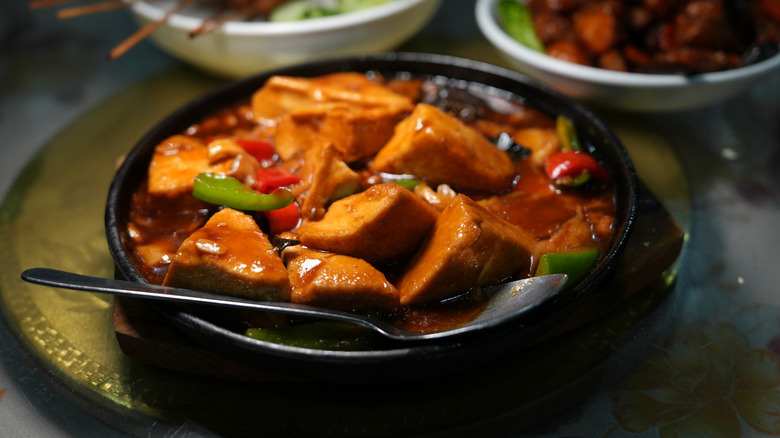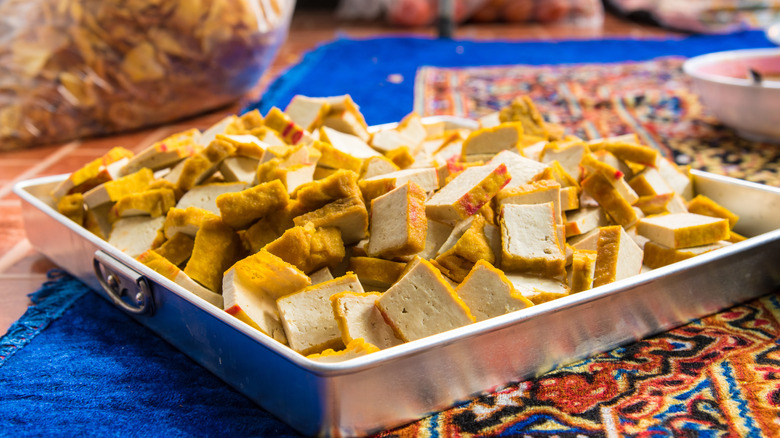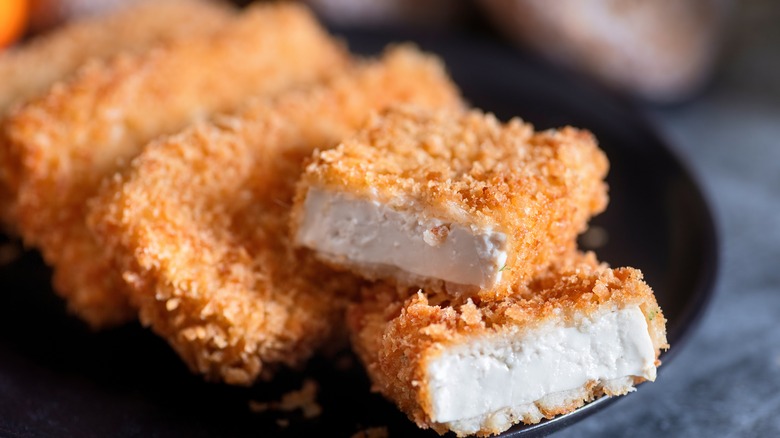Why Tofu Always Tastes Better At A Restaurant
Tofu can be extremely delicious, but it's hard to get right without the correct techniques. Maybe you've tried tofu at a few restaurants and thoroughly enjoyed your meal. Then, you get home and try to cook it yourself, only to make something bland, soggy, or otherwise underwhelming. You might be wondering, "What am I doing wrong?" Well, there are several reasons why tofu always tastes better at a restaurant.
There's a whole wide world of delicious tofu to be chowing down on. It makes sense to learn some restaurant secrets so that you can make it taste the way you want it at home. You don't have to suffer through tasteless tofu. From using more salt and oil to secrets for crispiness, like using cornstarch and breadcrumb coatings, professional chefs have a wide range of ways they make tofu taste better. Luckily, we have the details, so restaurant-quality tofu is within your reach. So, read on and you'll soon be cooking up and enjoying some of the best tofu of your life at home.
Restaurants know which type of tofu to use
Perhaps when you've cooked tofu in the past, you've just grabbed whatever brand and variety you came across first. But, there are several types of tofu, and some of them are better suited to particular dishes than others. The difference is that restaurants know which type of tofu to use, while not all home cooks have this advantage. Thankfully, this is easy to remedy with the right information.
So, what tofu is available, and what should you be using? First, let's start with regular or firm tofu. It holds its shape well when sliced and cubed, and is moderately firm but not overly dense. It's often used in stir-fries, curries, soups, and grilled or fried dishes. It absorbs flavors well, and can be marinated or seasoned as desired. Then, there's extra-firm tofu to contend with. It's the densest type of tofu with the least water content. It holds its shape exceptionally well and is quite sturdy. Due to its firmness, extra-firm tofu is perfect for grilling, pan-frying, or baking. It can be cubed and added to salads, used as a meat substitute in sandwiches, or even sliced and marinated for barbecue-style dishes.
Let's not forget about delicate silken tofu. It's ideal for blending into creamy dressings, sauces, and smoothies. It can also be used in desserts like puddings and cheesecakes. Some people enjoy it as a substitute for eggs in certain recipes due to its creamy texture.
They use more salt
There's one simple reason why tofu tastes better at a restaurant — it's prepared with significantly more salt. In many restaurant kitchens, chefs are trained to balance flavors meticulously. They understand the importance of seasoning, and use salt liberally to bring out the natural flavor of the dish. Tofu, being relatively mild and neutral in flavor, benefits from the right amount of salt.
On the other hand, when preparing tofu at home, some cooks may be more cautious about using salt, especially if they're health-conscious or trying to reduce their sodium intake. While there's nothing wrong with this, it can lead to tofu dishes that taste slightly bland compared to their restaurant counterparts.
The good news: There's a simple solution, and that solution is to use more salt when you cook tofu. Of course, it's wise to eat salt in moderation, so you shouldn't eat piles of super-salty tofu every night, but don't shy away from seasoning. That said, it's essential to strike a balance when using salt. Excessive salt can overpower the dish and even mask the delicate flavors of tofu. There are various ways to add more salt to tofu, from salting the whole block for a couple of hours before rinsing off the salt, to soaking sliced tofu in a salty brine. You can also simply add more salt to coatings and marinades.
They use more oil
Have you ever wondered how restaurants get their tofu so crispy and delicious? One of the culprits behind this delicious phenomenon might just be the generous dose of oil they add to the mix. When tofu from your favorite restaurant has a crispy, golden-brown exterior that's just begging to be devoured, oil is the magic behind that fantastic texture. The thing is, oil isn't just there for crispy indulgence — it's also a flavor carrier. When tofu hits the hot oil, it forms a beautiful caramelized crust that seals in all those wonderful tastes. The result is tofu that's bursting with rich, savory goodness.
When you make tofu at home, you might be mindful of how much oil you use. Just remember that oil isn't the enemy, and it's okay to use it with wild abandon every once in a while. You don't even have to deep-fry your tofu to get it crisp and delicious. Just use about a quarter of an inch of oil in the pan so it comes up around the sides of the tofu slightly, and flip your tofu a few times for even browning.
So, next time you're relishing the heavenly taste of tofu at a restaurant, remember the role of oil in this culinary love story. And don't be afraid to experiment in your kitchen — a touch of oil can take your homemade tofu from good to gourmet.
Chefs use cornstarch for a crispier exterior
It sometimes seems like a mystery how restaurants manage to achieve that perfectly crispy tofu exterior, but the answer lies in this unassuming ingredient — cornstarch. Cornstarch is tofu's BFF when it comes to creating that irresistible crunch. When you coat tofu with a light dusting of cornstarch before cooking, the cornstarch forms a thin, delicate layer around the tofu cubes, locking in moisture, and ensuring that they get a golden brown finish when cooked.
The real magic happens when heat meets cornstarch-coated tofu in the pan. As the tofu sizzles away, that thin layer of cornstarch begins to work its wonders. It protects the tofu from getting soggy, and helps it develop a fabulous crunch. This gives you tofu that's both tender on the inside, and satisfyingly crispy on the outside.
And here's another delightful thing about cornstarch-coated tofu: it's a blank canvas for flavors. Once you've got that crispy base, you can go wild with your seasonings. You can mix other ingredients in with the cornstarch, such as salt, garlic powder, herbs, and spices. Alternatively, you can get it crispy, and then add a glaze to the pan, mixing salty, sweet, and acidic ingredients for a dressing that gives you sticky, delicious tofu chunks. So, whether you're making tofu stir-fries, tossing it in a salad, or enjoying it as a standalone snack, cornstarch is the secret ingredient that elevates your tofu game.
Chefs know how to marinate tofu
Chefs in restaurants are well aware of how to marinate tofu, while your average home cook is sometimes left clueless. Without decent seasoning, tofu is always going to be fairly bland. While there are many ways to season tofu, marinating is a simple way that gets flavor deeper into each chunk or slice.
Professionals know what kinds of ingredients to use to flavor it effectively. Soy sauce is a common base for marinades because it's salty and rich in umami flavor. However, you should also balance that out with a bit of brightness from citrus juice or vinegar, and perhaps sweetness from maple syrup or agave nectar. Then, you can invite herbs and spices to the party, adjusting them depending on the dish you're making. For instance, for an Indian dish, you might use garam masala, while for an Italian dish, you might use oregano and garlic.
There's always going to be some water content in tofu, but it can still soak up plenty of marinade. Despite what some people advise, there's no need to press the tofu before cooking it. Nobody's ever walked into a professional kitchen to see hundreds of blocks of tofu being pressed under books and pots and pans. No, just dab the excess moisture off that sucker, and toss it in the marinade. Learning new ways to cook with tofu, like using marinades, is a key to tofu success.
There can be dry rubs involved
If giving your tofu a bath in a marinade isn't appealing, there's another great option for making it flavorful — a dry rub. You might be thinking that dry rubs are reserved for barbecue meats, but restaurants have a way of surprising us. Dry rubs can work wonders on tofu, too!
But, what exactly is a dry rub? It's a mix of herbs, spices, and other seasoning ingredients that you rub on the exterior of the food you want to flavor — in this case, tofu. Now, you might wonder why they call it a "dry" rub. Well, it's simple — there's no liquid involved here. The rub sticks to the tofu's surface, forming a delicious crust.
This might be many restaurants' secret recipe for delicious tofu, but there's no reason you can't try it at home. You can buy ready-made dry rubs with a balance of flavors, or you can experiment with DIY rubs to get your tofu tasting just the way you want it. So, the next time you find yourself marveling at that restaurant-style tofu, remember the power of the dry rub.
Tofu is sometimes frozen for a meatier texture
Brace yourself for another little-known secret that makes restaurant tofu extra special — the icy transformation of freezing. You heard us right. Some restaurants work their magic by freezing tofu, which gives it a firmer, meatier texture that works perfectly for some dishes.
So, here's how the cool transformation goes down. When tofu freezes and then thaws, returning to its original state, something remarkable happens. The ice crystals that formed during freezing expand and create little pockets within the tofu. These pockets give the tofu a more open and spongy texture, almost like little air pockets in bread. When you sink your teeth into this revamped tofu, there's extra substance and chewiness.
Of course, you can also unleash the power of freezing at home. Just grab some tofu, pop it in the freezer, and let it work its magic. Once it's defrosted, you can marinate it, add dry rubs, toss it in cornstarch, or try out any other restaurant-worthy tricks for better tofu.
Chefs don't use oil in marinades
Imagine this — you've tried soaking your tofu in a number of different marinades, but each time, not enough flavor is absorbed, and you're left with lackluster tofu. You think longingly about your favorite restaurant tofu, and wonder how they get the marinade to absorb so beautifully for flavorful tofu. Well, the secret that chefs know that you might not be aware of is that you should never add oil to a tofu marinade.
It might seem like a glug of extra-virgin olive oil will add some fruity complexity, or a hit of toasted sesame oil would add a fragrant smokiness. However, what can happen is that the oil ends up coating the exterior of the tofu, and acts as a barrier to keep the other ingredients out. It's such a simple thing, but even a small drizzle of oil might be what's standing between you and flavor perfection. If there's a flavor that you want from a particular oil, your best bet is to fry your tofu in that oil to add its taste to your dish. Or you could brush the oil on before baking tofu in the oven.
They cook tofu separately from other items
Are you cursed with soggy tofu? Well, it might be because you're doing something that many chefs avoid — cooking your tofu in the same pan as other ingredients. Of course, if you're making a stir-fry or curry where tofu is an ingredient, it's tempting to cook it in the same pan as whatever veggies you're using in the dish. But, this can lead you down an unhappy path to mushy, underwhelming tofu.
Tofu has a high water content, and when it comes into contact with moisture from other ingredients during cooking, it tends to release even more water, leading to a less-than-crispy outcome. Cooking tofu in a separate pan from other ingredients helps prevent it from going soggy, and helps it retain its desirable texture. It gives you more control over its exposure to moisture, so you can ensure that the tofu gets cooked evenly without becoming waterlogged. It also helps you to achieve that delicious golden-brown exterior and a crispy texture. To achieve these results, tofu needs high heat and dry conditions.
Cooking it separately in a well-heated pan allows the moisture to evaporate quickly, leaving room for the surface to caramelize and become crispy. That's before you consider that tofu can absorb the flavors of other ingredients present in the same pan. So, when you cook it separately, you don't have to worry about diluting or altering its taste with the flavors from other components of your dish.
Tofu is often served with flavorful sauces in restaurants
Perhaps all your tofu is missing is a really flavorful sauce. One trick that restaurants use is to pair tofu with a punchy sauce to balance a recipe. Sauces can make a huge difference to a finished dish. After all, what would pasta be without a rich ragu or a creamy alfredo? A vegetable curry is just a simple plate full of lightly-seasoned veggies without a curry sauce. So, why should tofu be any different?
Yes, it's perfectly possible to season tofu so that every bite is richly delicious, but that's not the only way of inviting flavor to the table. Rather, you can pair your tofu with a delicious sauce that you can enjoy with every mouthful. A flavor-packed sauce balances nicely with the naturally mild flavor of tofu.
The question is, what sauce should you use? Well, there are all kinds of options and no single correct answer. It really depends on what kind of dish you're trying to create. If you're looking to create an Italian meal, you could serve your tofu with a flavorful pesto. Or, if French cuisine is your bag, make a sauce out of browned butter, lemon juice, and capers. Think about what you're trying to achieve, and pick a sauce that fits the role at hand.
Some restaurants bake their tofu
While we've talked about the wonders of fried tofu, some chefs forgo this method in favor of baking. You might think that baking would result in a less crispy texture, but some chefs find that baking tofu gives it a satisfying crunch that sticks around for days.
Those restaurant chefs have mastered the art of baking tofu to perfection, and it shows in every delectable bite. So, how does it work? Chefs take that humble block of tofu, and carefully cut it into bite-sized pieces. Then, they give it a gentle toss in oil, and blast it on high heat until it's perfectly crisp and golden.
But, what about flavor? Some chefs marinate tofu before baking it, but the extra moisture can result in a chewy consistency, rather than a crispy one. Of course, sometimes that's exactly what you want. Other chefs try a dry rub, or coat tofu in cornstarch and spices before letting it hit the oven. There's also the option of keeping the flavoring simple, and pairing it with an intense sauce after baking. Baking also allows the flavors to meld and intensify, so you're left with something super special. Baked tofu is versatile, so it can shine in a variety of dishes. From salads to stir-fries, bowls to sandwiches, there's no limit to the delicious possibilities.
Some chefs bread or coat their tofu
Restaurants sometimes take humble tofu and elevate it to superstar status by breading it or coating it. If you're a fan of crispy, crunchy delights, this is one tofu adventure you don't want to miss. Coating tofu is like giving it a delicious makeover. It takes simple, delicately flavored tofu, and dresses it up in a tantalizing layer of crunchiness. Imagine biting into a piece of tofu with a golden-brown, crispy exterior that gives way to a tender center.
What's great about the breading or coating process is the opportunity to add in some extra flavor. Much like KFC's chicken has 11 herbs and spices in its coating, you can boost your tofu's flavor by adding seasonings to its outer layer. There's no end to the flavor combinations you can try — you could even create your own secret seasoning blend that you won't reveal to your friends and family.
While it isn't the easiest method to recreate at home, it's perfectly possible. You'll get the crunchiest results by deep-frying or shallow-frying your coated tofu, but there's also the opportunity to oven-bake it if you find frying overwhelming. So, whether you're a tofu enthusiast, or looking to add more plant-based options to your diet, coated tofu is a tasty choice. The blend of textures, the burst of flavors, and the sheer deliciousness of that crispy goodness make it an all-around winner.
